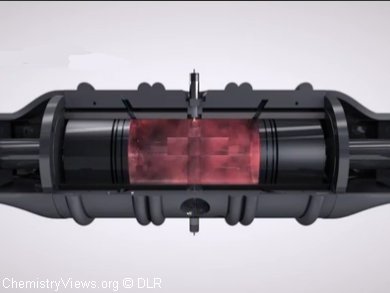To extend the range of electrically powered vehicles scientists at the German Aerospace Center (Deutsches Zentrum für Luft- und Raumfahrt; DLR) have developed a free-piston linear generator (Freikolbenlineargenerator; FKLG).
The free-piston linear generator works in a similar way to a conventional combustion engine. Instead of converting the linear movement of the piston into the rotational movement of the crankshaft, it generates electricity directly. A fuel-air mix is ignited in the combustion chamber. This expands and pushes the piston towards the gas springs. These decelerate the piston movement and push it back. The linear generator converts this kinetic energy of the piston into electricity. This in turn powers the electric motor.
In contrast to conventional drive technologies, the compression ratio, piston speed, and cubic capacity of the free-piston linear generator are flexible adjustable. This allows using different fuels like petrol, diesel, natural gas, ethanol, or hydrogen.
The free-piston linear generator makes it possible to use much smaller batteries in electric vehicles. Short distances of up to 50 km can be covered using only electrical power. For longer distances, the range extender takes over.
One of the tasks ahead is to optimize the weight and size of the free-piston linear generator in such a way that one or more of the assemblies can be located in the underbody area of a vehicle. By this an additional range of about 600 km could be achieved without increasing the weight of the car.
- Institute of Vehicle Concepts, German Aerospace Center (Deutsches Zentrum für Luft- und Raumfahrt; DLR), Stuttgart, Germany




